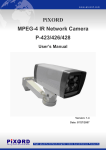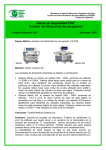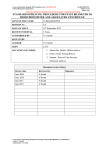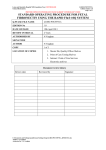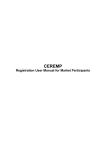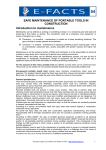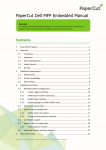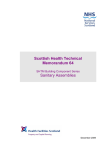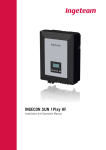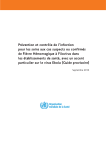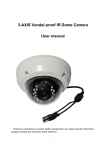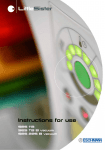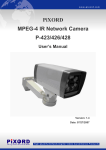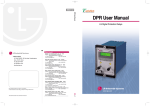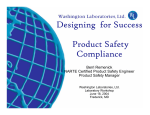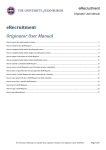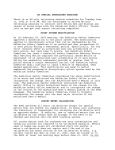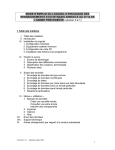Download HDL(2006)40 - Scottish Government Health Directorates
Transcript
NHS HDL (2006) 40 abcdefghijklm Health Department Directorate of Finance Dear Colleague July 2006 ______________________________ DECONTAMINATION – UPDATED GUIDANCE ON COMPLIANCE IN PRIMARY CARE Addresses Purpose Chief Executives: NHS Boards, NHS National Services Scotland, Scottish Ambulance Service and State Hospitals Board for Scotland 1. The purpose of this HDL is to provide revised deadlines for achieving compliance with the Glennie Technical Requirements for decontamination in Primary Care settings and provide an update on developments on issues relevant to decontamination, namely: For action For information Chief Executive, NHS Quality Improvement Scotland o P-CAT; Chief Executive, NHS Education for Scotland o Education; Directors of Finance, NHS Boards o SHPN 13; o Audit of SPS; and o A new Glennie Sub-Group for Decontamination Requirements. Revised Deadlines for Achieving Compliance 2. HDL(2005)1 issued in January 2005 provided deadlines for achieving compliance with the Glennie Technical Requirements for decontamination in Primary Care settings. Due to the unforeseen time required to develop the audit tool and identification of the significant time required to carry out an audit of all General Medical and Dental Practitioners, podiatrists, optometrists, and other healthcare professionals treating NHS patients and engaged in the local decontamination of re-useable instruments, the Sterile Service Provision Review Group (the Glennie Group) has revised the compliance deadlines. 3. In revising the deadlines the Group is clear that the deadline of 31st December 2009 by which time the physical environment and equipment at all local decontamination sites is to be upgraded is immovable. Medical and Nursing Directors, NHS Boards Chief Administrative Dental Officer, Dental Hospitals, NHS Boards Medical Director, HPS General Managers, Independent Hospitals Chief Executive Scottish Prison Service ______________________________ Enquiries to: Ross Scott Directorate of Finance Health Department Basement Rear St Andrew’s House EDINBURGH EH1 3DG Tel: 0131-244 2363 Fax: 0131-244 2371 Email: [email protected] _______________________ abcde abc a SE Approved Version 1.1 4. The revised deadlines differentiating between Directly Managed Units and Independent Contractors and the three phases of Action Plan are as follows: DIRECTLY MANAGED UNITS By 31st July 2006: Submission of Action Plan – Phase 1 The SQL Script supporting this action plan comprises approximately 20% of the overall non-compliances. By 30th September 2006: Submission of Action Plan – Phase 2 The SQL Script supporting this action plan comprises approximately 50 - 60% of the overall non-compliances. By 31st December 2006: Submission of Action Plan – Phase 3 The SQL Script supporting this action plan will comprise the remaining noncompliances. INDEPENDENT CONTRACTORS By 31st December 2006: All NHS boards will have completed the P-CAT audit exercise for all independent contractors (General Medical and Dental Practitioners, podiatrists, optometrists, and other healthcare professionals treating NHS patients and engaged in the local decontamination of re-useable instruments). By 31st March 2007: Submission of Action Plan – Phase The SQL Script supporting this action plan comprises approximately 20% of the overall non-compliances. By 30th June 2007: Submission of Action Plan – Phase 2 The SQL Script supporting this action plan comprises approximately 50 - 60% of the overall non-compliances. By 30th September 2007: Submission of Action Plan – Phase 3 The SQL Script supporting this action plan will comprise the remaining noncompliances. 5. Action Plans for the compliance with Glennie Technical Requirements for both Directly Managed Units and Independent Contractors should be submitted to Ross Scott at SEHD for approval for all local decontamination units. 2 SQL Scripts/Action Plans 6. In order to facilitate standardisation of action plans and a staged approach to corrective action, HPS has developed a series of three software applications (SQL Scripts) and corresponding standardised action plans for each of the three phases. Each SQL Script is programmed to search global data for specific non-compliances and identify the sites to which the non-compliances apply. This information allows Boards to complete the corresponding action plans for the required phase. The action plan is populated with the corresponding non-compliances for each phase. 7. Boards are required to enter the following data into each of the action plans, for each applicable non-compliance: o Number of sites per non-compliance – by 31st July this will be the number of Directly Managed Units per non-compliance; o Risk level – high, medium, low; o Has a risk assessment been carried out?; o Corrective action required; o Timescale for resolution – e.g. 0 – 3 months, 3 – 6 months or 6 – 12 months. o Action by; o Estimated completion date; o Estimated cost; o Priority – high (1), medium (2), or low (3). When submitting Action Plans, Boards will be required to explain instances where for example a high-risk non-compliance has an estimated completion date of more than 3 months or is not assigned a high priority. 8. Each of the three SQL Scripts covers each of the sections in the Primary Care Audit Tool and identifies a range of non-compliances, some of which will require planning and investment, as well as other non-compliances requiring more simple action. 9. These scripts, associated user documentation and standardised action plans are available on request from HPS (Decontamination Team Administration – [email protected] or Tel 0141 300 1945). The release dates of this software and supporting documents will be staggered in line with dates for submission of action plans. It is highly advised that the SQL Scripts are installed and executed by IT professionals. In order to run the SQL Scripts, NHS Boards require Microsoft SQL Server software. 10. Action plans for directly managed units - after the data has been processed by the SQL Scripts any test sites and independent contractor sites will have to be identified and removed from the results. Please refer to user manual. Action plans for independent contractor sites - after the data has been processed by the SQL Scripts any test sites and directly managed units will have to be identified and removed from the results. Again, please refer to user manual. Further support is available from HPS (Robert Heaney, Systems Developer – [email protected] or Tel 0141 300 1945). 11. It is anticipated that through the combined processes of risk management and corrective action both the standard and safety of decontamination practices will be significantly improved NHS boards which feel that they cannot comply with any of the deadlines within this revised timescale should notify Ross Scott (see contact details on the 3 front page) by Friday 21st July 2006 explaining why the deadline(s) cannot be met and seek agreement to an alternative deadline(s). The P-CAT Audit Tool Training 12. HPS ran a very successful 3 week course last October to train staff to carry out P-CAT audits. Since then, HPS has provided support to the trained P-CAT auditors and this has tremendously helped a number of boards to make progress with their P-CAT audit requirements. The potential need for additional staff to be trained as auditors has been identified due both to higher than anticipated workload for auditors and the attrition of trained staff. Accordingly the Glennie Group has agreed that a further 3 week training course should be presented by HPS, if required, and is planned to commence on Monday 4th September 2006. 13. Meantime, NHS boards should be assessing their training needs and identifying individuals of A&C grade 5/6 or above, ideally with a science, engineering or other technical background and basic IT skills to be trained. A specific trawl for delegates will be carried out before the end of June. Education 14. After a problematic start, NES and HPS are now working at full speed on the delivery of a Primary Care Decontamination Training Programme. The Programme will be based on the Department of Health’s successful Decontamination Programme delivered by Intuition but heavily customised to suit Primary Care settings in Scotland. The DH Programme is based on 15 modules and at this stage it is considered that only one of the modules is not appropriate for a Primary Care Programme. Work has commenced on reviewing the modules and it is anticipated that the first few modules will be complete by early autumn, and the remainder of the modules will be incrementally released soon thereafter. Further details about publicity and roll out will be provided in due course. Scottish Health Planning Note 13 15. Health Facilities Scotland has been commissioned to prepare guidance for NHSScotland on the provision, management and operation of decontamination facilities in both acute and primary care settings. The guidance which will be badged as SHPN 13 – Decontamination Facilities, and will cover two main areas: o Planning and design of decontamination facilities, including those in primary care settings; and o Management and operation of decontamination facilities, including those in primary care settings. 16. HFS aim to issue a draft of the note on primary care by the end of July. Audit of SPS 17. There has been some confusion over where responsibility lies for the P-CAT audit of facilities within prisons. This is a very high risk population in terms of HIV & hepatitis therefore it is extremely important that infection control/decontamination processes are robust. This matter is currently under discussion with SPS. 4 18. A New Glennie Sub-Group for Decontamination Requirements 19. Following recent discussions with Dental Practitioner decontamination representatives it has been agreed that a new short life group meet to review the current position with regards Glennie Technical Requirements (TRs) for GDPs. This group will also address advice available to Dental Practitioners on the interim steps required to be taken by practices in advance of being fully compliant to the TRs and investigate the real issues preventing practices from being compliant. Membership of this group will include a number of GDPs, as well as representatives from Health Protection Scotland, Health Facilities Scotland, NHS Education Scotland and P-CAT auditors. Advice on the decontamination of re-usable surgical instruments and other re-usable medical devices in General Medical Practice 19. Annex A contains a paper prepared by the Primary Care Sub-Group to provide advice on the decontamination of re-usable surgical instruments and other re-usable medical devices in General Medical Practice. Please ensure that copies of this Annex are made available top General Medical Practitioners and Practice Managers. Action 20. NHS Board Chief Executives should comply with the revised compliance dates and bring the contents of this HDL to the attention of: o All General Medical and Dental Practitioners, podiatrists, optometrists, and other healthcare professionals engaged in the local decontamination of re-useable instruments; o Practice Managers; o Infection Control Managers for onward dissemination to infection control teams and those involved in local decontamination; o Sterile Services Managers; o Directors of Public Health; o Consultants in Public Health Medicine (CD&EH); o Consultants in Dental Public Health; o Clinical Directors of Dental Services; o Risk Management Committees; o Clinical Governance Committees; o Directors, Primary Care Estates; and o Any other relevant staff. Yours sincerely ALEX SMITH Interim Director of Finance 5 ANNEX A Advice on the decontamination of re-usable surgical instruments and other re-usable medical devices in General Medical Practice Glennie Group Primary Care Strategy Subgroup CONTENTS: A. Strategic approach B. Local decontamination of re-usable surgical instruments and other re-usable medical devices: 1. 2. 3. Annex 1: Annex 2: Annex 3: Annex 4: Upgrading premises to provide suitable decontamination facilities Decontamination equipment, including installation and commissioning Clarification of other related issues Priorities for immediate action [CMO/CDO letter CMO(2004)21] Further sources of information on local decontamination Detergents for manual cleaning of instruments Model layouts for local decontamination facilities abcdefghij 1. Advice on the decontamination of re-usable surgical instruments and other re-usable medical devices in General Medical Practice A. STRATEGIC APPROACH General Medical Practitioners (GMPs) require sterile instruments and accessories in order to undertake a number of procedures. These include treatment room procedures such as dressings and wound care, removal of sutures and family planning procedures (e.g. use of vaginal specula). In addition, many GMPs undertake a variety of surgical and investigative procedures as well as suture of wounds, all of which require sterile equipment. Other visiting practitioners (e.g. podiatrists) may also undertake such procedures on the premises. To meet national standards relating to safe working practices for practitioners and patients, GMPs are advised to assess their procedures and to carry out an appraisal of the best option for their practice. In order of preference, these options are: 1. Employ only ‘single use’ instruments and other medical devices, sterile supplies and dressings. 2. Reprocess instruments and medical devices via Decontamination Unit (CDU) if this is available locally. 3. If neither of these options is operationally or financially viable, establish a local decontamination unit (LDU), which is compliant with current regulations and guidance. a Central The key message is that GMPs should only undertake local decontamination as an option of last resort. It may be that a combination of options represents the best solution for some practices. An option appraisal framework is available within the document Local Decontamination Units: Guidance on the Requirements for Equipment, Facilities and Management produced by Health Protection Scotland for the Glennie Group: http://www.show.scot.nhs.uk/scieh/infectious/hai/decontamination/documents/LDU_Guidance/251005LDUGuidance.pdf Single use instruments are now available in wide variety and high quality. These are increasingly available through national contracts, which seek to minimise costs for NHSScotland. Disposal of single use instruments should be in accordance with Scottish Hospital Technical Note 3 (SHTN3) - Management and Disposal of Clinical Waste [see Annex 2 for links]. NHS Board Decontamination Advisers and/or Infection Control Teams will be able to advise practices on assessing the safest and most cost effective ways of ensuring the necessary supply of appropriate instruments, whether as disposable, or from a CDU. The remainder of the current document is aimed at those practices who for various reasons wish to (or have to) undertake local decontamination within their own premises. This is a complex and costly process and it is regulated by numerous technical standards and regulations that have to be met by those undertaking decontamination. It is very important to note that the GMS Contract requires all practitioners to undertake decontamination in line 1. with current guidelines and regulations; running a compliant Local Decontamination Unit is neither a cheap nor an easy option. This document aims to give a simple overview and broad principles, with direction towards specific technical resources and sources of advice for tackling any specific issues. It also meshes with the ten priority areas for action (attached for information at the end of this advice note as Annex 1) which were circulated with the CMO/CDO Letter CMO(2004)21. 2. B. LOCAL DECONTAMINATION OF RE-USABLE SURGICAL INSTRUMENTS AND OTHER RE-USABLE MEDICAL DEVICES A number of guidance documents have been issued from various sources in the past few years. This is also an evolving field, and new guidance will of necessity be required as the underpinning science develops. The main source of advice for NHS Scotland is the ‘Glennie’ Group, and its Primary Care Strategy Subgroup. The current document aims to pull the relevant sources together, and to outline in straightforward pragmatic terms the critical issues to address in upgrading premises, equipment and ways of working. The main practical guidance document for local decontamination is Local Decontamination Units: Guidance on the Requirements for Equipment, Facilities and Management (LDUG) produced by Health Protection Scotland for the Glennie Group: it runs to 57 pages and should be downloaded as a reference resource. It is available at: http://www.show.scot.nhs.uk/scieh/infectious/hai/decontamination/documents/LDU_Guidance/190105_Local% 20Decontamination%20Units%20Guidance.pdf or can be obtained in hard copy from HPS (see Annex 2 for addresses and HPS decontamination website). Specific numbered sections of this guidance are referred to below as e.g. LDUG 2.2. The LDU guidance in turn refers on to the appropriate Scottish Health Technical Memorandum (SHTM) documents, which are more detailed still and outline the various regulatory requirements. 1. Upgrading premises and equipment to provide suitable decontamination facilities. GMPs work in a variety of premises, with varying available space and room shapes that can compromise the adoption of ‘ideal’ solutions. Whilst some practices have invested heavily in refurbishment, or have moved to new premises, they may continue to have fundamentally unsuitable decontamination facilities through simply not being aware of basic principles. Any practice looking to develop a new facility should ensure that this meets all the requirements and regulations, and have all plans appropriately scrutinised. See Section 1.3. Many, if not most General Practices undertake manual cleaning of instruments prior to sterilizing in a bench top sterilizer. While this may suffice (and in a few instances is the only method of cleaning for some equipment, where this is the manufacturer’s instruction), it is not sustainable in the long term for the reasons stated in Section 3.1. Facilities and equipment should be upgraded to move away from manual cleaning to use of automated washer-disinfectors. See Section 2.1. 1.1 The ideal facility The ideal set-up is a dedicated room (or rooms) for decontamination, which is separate from patient treatment rooms, that is designed to establish a dirty-to-clean workflow [LDUG 2.2]. The best arrangement would comprise a single run of sealed, easily cleaned worktop with (in order): • • • a setting down area for dirty instruments; ultrasonic cleaner; a washing sink with detergent dispenser; 3. • • • • • • • • • • a setting down area for manually cleaned instruments; a rinsing sink; a setting down area for rinsed instruments; an automated washer-disinfector; a setting down area for machine-processed and/or manually cleaned/rinsed instruments, with task lighting for inspection (for visible contamination and functionality/damage) [LDUG 2.8]; an area for wrapping instruments prior to sterilization in a vacuum sterilizer* a steam sterilizer; an area for setting down and wrapping sterilised instruments* [LDUG 2.9, 2.11]; clean, dry, orderly storage for instruments prior to use [LDUG 2.12] arrangements for safe transport of instruments to the clinical area in a clean rigid box with lid [LDUG 2.13.1]. * NB the few practices using a vacuum sterilizer would wrap instruments before sterilizing Some suggested layouts are given in Annex 4: the above basic system within a single room is represented there by option 5. The provision of an additional dedicated wash hand basin and personal protective equipment storage is important for infection control and staff safety. There are currently no national standards or formal guidance on air quality/ventilation for local decontamination units, although further information will be contained within the forthcoming Scottish Health Planning Note on local decontamination (SHPN 13). Where ventilation is used, it should be installed to ensure that air is drawn from the source of contamination directly out of the processing area. Maximum working temperatures are not legally specified, but an HSE leaflet Thermal comfort in the workplace – guidance for employers says than an acceptable zone of comfort for most people in the UK is between 13oC (56oF) and 30oC (86oF). A shared dedicated decontamination facility is likely to be a better and more cost-effective solution for a multiple surgery practice – further options for this are suggested in Annex 4. 1.2 Where space is limited In all cases the above dirty-to-clean workflow must be maintained. Lack of space may dictate that a setting down space has to be used for both dirty and clean instruments at various points in the decontamination process: if so, the surface must be thoroughly cleaned between steps with a detergent and water solution (with or without alcohol [LDUG 3.6]) to prevent crosscontamination. If there is space for only one sink, rinsing may be carried out using a clean plastic bowl. These constraints will inevitably make processes more difficult for the member of staff carrying them out, and will increase the risks of cross-contamination. This degree of compromise indicates that the physical premises may not be fit for purpose in the longer term. Lack of space may also dictate that decontamination has to be carried out in a patient treatment room. Decontamination should be deferred until the room is unoccupied [LDUG 2.2], and Annex 4 option 5 provides a suitable approach to layout. 4. 1.3 Getting it right It is important that basic requirements are taken into consideration at the design stage – dedicated space, two sinks (with an additional separate wash hand basin), adequate work surface, layout which facilitates dirty-to-clean workflow, ventilation, suitable storage (for sterilised instruments, detergents, disinfectants, cleaning brushes, personal protective equipment), storage for water (or space for RO/still units), suitable plumbing, and bench space for ultrasonic washers, washer/disinfector and sterilizers. If you are contemplating refurbishment/upgrading work, please contact your NHS Board Decontamination Advisor and Infection Control Team. The Health Protection Scotland Decontamination Team can advise on technical and design issues (0141 300 1945, [email protected]). Scottish Healthcare Supplies can advise on procurement of decontamination equipment (031 275 6000, [email protected]) 2. Decontamination equipment, including installation and commissioning 2.1 Washer disinfectors (WDs) [LDUG 2.16.8] It is intended that as many sites as possible move to using automated washer disinfectors (WDs) within the next three years. There are now some suitable benchtop models on the market, but seek advice on recommended best options from Scottish Healthcare Supplies or Health Protection Scotland (see Annex 2). The HPS decontamination website will include advice on this in the near future: http://www.show.scot.nhs.uk/scieh/infectious/hai/decontamination/haidecon.htm. WDs all require to be commissioned on site, prior to use, by a suitably qualified person – they are not “plug in and use” machines, and believing that they are is a common and expensive mistake. It has to be the correct machine for your needs, correctly installed, in the right location, with the right plumbing connections, and formally commissioned. When purchasing WDs, make sure you specify that installation and commissioning to SHTM 2030 (Washer Disinfectors) is part of the contract. You should also insist on a validation certificate signed by the qualified Test Person (Sterilizers), which should then be signed off by an Authorised Person (Sterilizers) for your records [LDUG 3.5]. Staff will require training in proper and safe use of WDs, as they do for all decontamination equipment. Additional staff time required for daily testing and maintenance of WDs will be offset at least in part by the savings on time spent manually cleaning instruments. The cycle time will depend on the type of machine purchased, and particularly on whether a there is a drying stage. 2.2 Steam sterilizers [LDUG 2.10, 2.16.22, 2.16.29 ] Vacuum (wrapped instrument) sterilizers and non-vacuum (unwrapped instrument & utensil) sterilizers are suitable for instrument decontamination, provided that national guidance on validation, maintenance and testing as specified in SHTM 2010 is followed. Most practices use non-vacuum sterilizers. Recommended equipment is available through national contracts. Scottish Healthcare Supplies can advise (031 275 6000, [email protected]). 5. In order to quality assure the process, the sterilizer must be able to record pressure and temperature achieved during the sterilising cycle via an independent process verification recorder. These data should act as a permanent record, whether as paper or as a dated computer record. This should be specified in the contract when buying, as should installation and validation to SHTM 2010 (Sterilization) – similar to section 2.1 above. Recorders can also be retrofitted to some existing sterilizers. Whichever machine you use, it is essential that daily, weekly, quarterly and annual testing is performed and recorded in a sterilizer logbook. A sterilizer equipped with an independent process verification recorder makes the process of record keeping easier. Further detailed guidance relating to local decontamination equipment available on central contract (MEK 005 CONTRACT Benchtop Sterilizers, Ultrasonic Cleaners & Benchtop Washer Disinfectors) will be available in the very near future. NB: Remember that separate specific Pressure Vessel Insurance is a legal requirement. Pressure Vessel Indemnity must be in place and the sterilizer inspected by a Competent Person (Pressure Vessels) at least once in every 14 months. It is a mandatory requirement by law that a written scheme of examination is available with each sterilizer / pressure vessel in line with the Pressure Systems Safety Regulations (2000). Your insurance company who provides 3rd party liability for the pressure vessel should be able to provide this service. 2.3 Water for use in steam sterilizers and washer disinfectors Steam sterilizers The requirement (SHTM 2031 Clean steam for sterilization and SHTM 2010) is for water that is free of chemicals and pyrogens. Tap water is not suitable on either count: this must be Sterile Water for Irrigation BP or freshly produced reverse osmosis (RO) water or freshly produced distilled water. Seek guidance before purchasing RO or distilled water units. Washer disinfectors To avoid recontamination of instruments following a thermal disinfection cycle in a WD, water that meets the requirements of the current LDU guidance should be used. The preferred option is RO water from a properly maintained system. Cleaned/washed instruments should ideally be rinsed in this same quality of water prior to sterilization, but mains tap water is acceptable for this purpose if instruments are dried before sterilization [LDUG 2.7]. 3. Clarification of other related issues 3.1 Manual cleaning of instruments [LDUG 2.5, 2.16.1] The best option to ensure quality and consistency of cleaning is to use an automated washer disinfector (WD), the next best is to use an ultrasonic bath for cleaning, and manual cleaning alone is acceptable as a third (if least good) option. Manual cleaning is variable in quality and cannot be quality controlled. It also poses potential health & safety risks to staff e.g. through injuries to hands and generation of aerosols [LDUG 2.17.4, 3.3]. Cleaning brushes should be single-use or thoroughly cleaned and stored dry after use. 6. 3.2 Detergents for cleaning instruments Detergents specifically formulated for manual or ultrasonic cleaning of instruments should always be used. Note that chlorhexidine (e.g. Hibitane®) handscrub, washing-up liquid, cleaning creams or soap should not be used: chlorhexidine in particular makes proteins stick to steel. Examples of suitable products are available on the FAQs page of the HPS decontamination website: the current version and the web address are attached at Annex 3. 3.3 Buying new instruments [LDUG 2.1] Before purchasing new instruments, you should check with the manufacturer (or supplier) whether they are compatible with the decontamination processes available to you. If not, another brand or type of instrument should be chosen. 3.4 Single use instruments (designated by symbol) Practitioners must agree practice policies/protocols with staff so that every member of the practice team is aware of which instruments are single use and which are designed for reuse after decontamination. Items designated as single use must never be re-processed, and should be disposed of after use. Policies should detail the procedures for safe disposal. [See links in Annex 2: SHTN3 and DB(2000)04] 3.5 Education and training in local decontamination [LDUG 2.17.1] All personnel carrying out decontamination processes should have a formally documented training needs assessment and a record of training received in accordance with the Glennie requirements [LDUG 1, 2.17.2]. NHS Education for Scotland (NES) in collaboration with Health Protection Scotland (HPS) are developing a new practice based training package, the first modules of which should be available later this financial year. 3.6 Priorities for action relating to current practice Following the national survey of dental decontamination reported in 2004, all general dental and medical practitioners were asked to ensure that ten basic points of good everyday practice in local decontamination were addressed as outlined by the letter from the Chief Medical and Dental Officers CMO(2004)21, dated 25 November 2004. Many of the points in the current document were raised in that circular. The text of the priorities for immediate action, also developed by the Primary Care Strategy Subgroup, is reproduced below as Annex 1. Scottish Executive Health Department July 2006 7. [CMO/CDO letter CMO(2004)21] ANNEX 1 Local Decontamination of Instruments in Primary Care and Related Settings Please share and discuss these priorities with all members of your team, and regularly review and audit the decontamination processes within your practice Priorities for immediate action 1. Don’t re-use ‘single use’ items Single use items should be labelled as such - the symbol used on packaging is Specifying a medical device as single-use is the responsibility the manufacturer of the device. Once removed from the packaging there may be no labelling on the device itself ensure that it is clearly segregated from re-usable devices of similar appearance. 2. Ensure that decontamination equipment (washer-disinfectors, ultrasonic cleaners, heat sealers, sterilizers, water treatment units) is used in accordance with the manufacturers instructions. If you don’t have the instruction manual for your ultrasonic cleaner, steriliser, or other equipment, make sure you get a copy - please read it and follow the written instructions. Your NHS Board Authorised Person (Sterilisers) or Scottish Healthcare Supplies may have a copy of the appropriate steriliser instructions if the manufacturer can’t supply one – contact details are in Annex 2. 3. Ensure that decontamination equipment is properly maintained day-to-day. Change the water in the reservoir of bench top steam sterilizers regularly – at least daily – using purified bacteria-free water (this can be freshly prepared distilled or reverse osmosis (RO) water, or sterile water for irrigation – there may be local bulk purchasing arrangements for the latter). Change the solution in the ultrasonic bath regularly – at least each morning /afternoon session, or more frequently if there is a high throughput of contaminated instruments. Remember that RO and distillation equipment need regular maintenance too – check the manufacturer’s instructions. 4. Ensure that decontamination equipment is tested regularly to ensure that it is working. Is your steriliser working properly? If not, all your work counts for nothing. Get your sterilizer tested now, and get it serviced quarterly by a qualified person. Do you know if your ultrasonic cleaner is actually working? You can carry out a test for your ultrasonic bath now, and add this to your maintenance contract. 5. Ensure that the load to be sterilized is appropriate for the type of sterilizer being used. Don’t wrap instruments or place them inside a solid bowl before sterilising in a bowl & instrument type sterilizer (also known as an unwrapped instruments and utensils sterilizer) – they won’t sterilise reliably. Only wrap before sterilising if you have a vacuum (or forced air removal) type steriliser - if in doubt, consult the instructions. If you are wrapping after sterilization, remember to visually check instruments for dryness first. 8. 6. Ensure you have pressure vessel insurance for pressure vessels in your practice. If you have a steam sterilizer of any type, you are legally required to have specific pressure vessel insurance. NB standard generic insurance policies do not cover this. Your insurance broker or Primary Care Estates advisor can help. There may be local discounts for bulk policy purchase available. 7. Ensure the layout of your decontamination facility is fit for purpose. Decontamination should be segregated from other activities so that cross-contamination cannot occur. The flow of work should be a one-way trip from dirty at one end of the bench to sterile at the other. Don’t splash or drip dirty water onto sterilised instruments, or onto the surfaces they will be laid out on. If space is short, clean up between parts of the process. Don’t use the same sink for cleaning instruments prior to sterilisation and other activities (e.g. general cleaning, food/drink preparation, hand washing), and especially keep cups and plates well away from where they could be splashed while cleaning dirty instruments. If you have only one all-purpose sink, use dedicated bowls to clean and rinse instruments as an interim measure, and decontaminate the bowls regularly. When cleaning instruments by hand, keep brush and instruments under the water while scrubbing to prevent splashes and aerosols. 8. Use the correct detergent solution for manual cleaning. Use a neutral detergent intended for use with medical devices, at the correct amount, in the right volume of water, at a hand-hot temperature. Plain water won’t do the job. Don’t use inappropriate cleaning agents: chlorhexidine (hand) scrub makes proteins stick to metal and does not aid cleaning; abrasive cleaners can cause scratches which can trap contamination. 9. Staff involved in decontamination should wear suitable personal protective equipment - eye and mouth protection, gloves, waterproof apron. Remember that good hand hygiene and basic infection control precautions are essential for staff and patient safety. 10. When buying new instruments, always check with the supplier that they are compatible with your own decontamination processes. Some instruments have very specific requirements for decontamination. If you can’t meet these requirements given the facilities and procedures you use locally, decontamination may be ineffective and the manufacturer’s warranty may be invalid. Scottish Executive Health Department November 2004 9. ANNEX 2 Further sources of information on local decontamination 1. Sources of Support and Advice • • • • • • Authorised Person/s (Sterilizers) - name dependent upon NHS Board area: Health Protection Scotland, 1 Cadogan Square, Cadogan Street, Glasgow, G2 7HF, Tel. 0141 300 1945, e-mail [email protected] . Local ‘Responsible Person’ (Decontamination Equipment) - e.g. Principal Engineer, Primary Care/Community Health Divisions or other designated person/s responsible for Decontamination equipment. Sterile Service Managers – via NHS Board Head Offices. Public Health Infection Control Nurse or Infection Control Nurse (as appropriate) – via NHS Board Head Offices Decontamination technical enquiry service at Health Protection Scotland (previously SCIEH), 1 Cadogan Square, Cadogan Street, Glasgow, G2 7HF Tel. 0141 300 1945, email [email protected] Primary Care/Community Health Division Decontamination Groups (where Medical and Dental practitioners along with other service providers are represented) – via NHS Board Head Offices. 2. Useful Websites • • • • Health Protection Scotland decontamination pages: http://www.show.scot.nhs.uk/scieh/infectious/hai/decontamination/haidecon.htm The Glennie Report (2001): Appendix D1A (Decontamination technical requirements: section on low risk category): http://www.show.scot.nhs.uk/sehd/publications/sspr/sspr-11.htm ; The Glennie Report (2001): Appendix D3 (Protocol for local decontamination of surgical instruments): http://www.show.scot.nhs.uk/sehd/publications/sspr/sspr-14.htm ; Standard Infection Control Precautions: http://www.show.scot.nhs.uk/scieh/infectious/hai/infection_control/SICP/StandardPrecautions.htm • • • • • CMO/CDO Letter CMO(2004)21 full text: http://www.show.scot.nhs.uk/sehd/cmo/CMO(2004)21.pdf SHTM 2010 and 2030: http://www.show.scot.nhs.uk/pef/guest/decontamination/CDVer2/Contents1.pdf Scottish Hospital Technical Note 3 (SHTN3) - Management and Disposal of Clinical Waste: http://www.pef.scot.nhs.uk/guest/ or (NHSnet users only): http://www.pef.scot.nhs.uk/secure/clinicalwaste/SHTN3V4/index.htm Medical Devices Agency Bulletin DB2000(04) - Single-use Medical Devices: Implications and Consequences of Reuse: http://www.mhra.gov.uk/home/idcplg?IdcService=SS_GET_PAGE&useSecondary=tr ue&ssDocName=CON007348&ssTargetNodeId=572 MDA Bulletin DB2002(06) Benchtop Steam Sterilizers – Guidance on Purchase, Operation and Maintenance http://www.mhra.gov.uk/home/idcplg?IdcService=SS_GET_PAGE&useSecondary=tr ue&ssDocName=CON007326&ssTargetNodeId=572 10. ANNEX 3 Detergents for manual cleaning of instruments: advice from Health Protection Scotland (May 2005) – check FAQs page of the HPS decontamination website for updates at: http://www.show.scot.nhs.uk/scieh/infectious/hai/decontamination/faq.htm#decontamination 11. Model layouts for local decontamination facilities (Health Protection Scotland) The options considered are: ANNEX 4 1 Typical existing unsatisfactory layout: all decontamination activity in treatment room compare option 5 for workflow/space • All decontamination activity in treatment room • Separate facility for “dirty” process for single treatment room (2 options) • Separate facility for “dirty” process for multiple treatment rooms • Separate facility for all decontamination activity; single room + B&I sterilizer Treatment zone eg dental chair • Separate facility for all decontamination activity; single room + Vacuum sterilizer Ultrasonic • Separate two room decontamination facility with pass-through WD B&I Sink Sterilizer Note: PPE = Personal Protective Equipment WHB Segregation of dirty decontamination activity from patient a rea area 2 3 Single treatment room + decontamination room (Option A) Treatment room Segregation of dirty decontamination activity from patient area; Single treatment room + Decontamination area (Option B) Product flow Product flow Hatch Hatch P P E Treat room & Clean decon Treat room & B&IB & I Dirty Decon Dirty Decon Treatment zone eg dental chair Treatment zone eg dental chair WD/Ultrasonic Sink PPE B&I Clean decon WD/Ultrasonic Sterilizer B&I or Vac WHB 12. Sink Sterilizer B&I or Vac WHB 4 Single room for local decontamination - bowl and instrument sterilizer Segregation of dirty decontamination activity from patient area; Decontamination area serving one or more surgeries. (Sterilized devices only) 5 ‘ DIRTY’ ZONE Put down Treat room & Clean ‘ Rinse Inspect CLEAN’ ZONE Sterilize Clean decon Pack/store B&I Dirty Decon PRODUCT FLOW B&I P P E Treatment zone eg dental chair Air flow PERSONNEL Ultrasonic / WD PPE Sink Sterilizer Used devices WHB Transfer in WHB Lidded containers Clean, non -sterile devices Single room for local decontamination – vacuum sterilizer 6 ‘ DIRTY’ ZONE Clean Rinse Inspect, dry & pack ‘ CLEAN’ ZONE Sterilize Treatment zone eg dental chair Treat room Two room local decontamination– vacuum sterilizer (Sterile devices– invasive procedures possible) Put down Clean Rinse Inspect, Pack Store Sterilize Store WD Vac Clean Decon Dirty Decon Sink 7 (Sterile devices – invasive procedures possible) Put down Ultrasonic Sterilizer B&I or Vac Vac PRODUCT FLOW PRODUCT FLOW Air flow Air flow Air flow PERSONNEL GOWN PERSONNEL PPE ‘ PPE CLEAN’ ZONE ‘ DIRTY’ ZONE Sterilizer WHB Ultrasonic Sink Dirty Decon Treatment zone eg dental chair Clean Decon Sterilizer Treat room WHB 13. Ultrasonic / WD Sink Dirty Decon Treatment zone eg dental chair Clean Decon Treat room



















